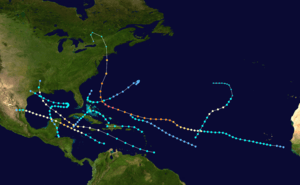1938 January hurricane
| Category 1 hurricane (SSHWS/NWS) | |
| Formed | January 3, 1938 |
|---|---|
| Dissipated | January 6, 1938 |
| Highest winds |
1-minute sustained: 80 mph (130 km/h) |
| Lowest pressure | 992 mbar (hPa); 29.29 inHg |
| Fatalities | None |
| Damage | None |
| Areas affected | No land areas |
| Part of the 1938 Atlantic hurricane season | |
Hurricane One of the 1938 Atlantic hurricane season is the earliest-forming tropical or subtropical cyclone on record in the Atlantic basin (Hurricane Alice in 1955 and Tropical Storm Zeta in 2006 both existed earlier in January, but neither formed in January, both having formed the previous December and lasted into January), and one of only three Atlantic tropical cyclones on record to form during the month of January (the others being Tropical Storm One in 1951 and Hurricane Alex in 2016). It formed on January 3 southwest of the Azores, and throughout its existence as a tropical cyclone it maintained a general southwesterly track. The storm attained peak winds of about 80 mph (130 km/h) and never threatened land, dissipating on January 6. Only five other tropical or subtropical cyclones are known to have existed in January: Alice in 1955 and Zeta in 2006, neither of which formed in January (see above), Tropical Storm One in 1951, Subtropical Storm One in 1978, and Alex in 2016.
Meteorological history

On January 1, a weak extratropical cyclone formed about 2,000 miles (3,200 km) southwest of São Miguel Island in the Azores. Moving eastward initially, it later began a turn to the south on January 3. On that day, the cyclone transitioned into a warm-core system, a tropical storm with winds of 60 miles per hour (97 km/h). The storm gradually curved to the southwest and became a hurricane on January 4, the equivalent of a Category 1 on the modern Saffir-Simpson hurricane wind scale. It peaked with winds of 80 mph (130 km/h) that same day but weakened back into a tropical storm on January 5. Turning to the south-southwest, it dissipated on January 6 while centered well to the east of the Lesser Antilles. The cyclone became the first documented Atlantic tropical cyclone to attain hurricane intensity in the month of January, and is one of just six Atlantic tropical or subtropical cyclones known to have existed in that month, the others being Tropical Storm One in 1951, Hurricane Alice in 1955, Subtropical Storm One in 1978, Tropical Storm Zeta in 2006, and Hurricane Alex in 2016;[1] it remains the earliest-developing tropical cyclone on record in the Atlantic basin, and the second-strongest Atlantic tropical cyclone on record to have formed in the month of January (after only Alex).
Impact and records
The storm was the first Atlantic tropical cyclone on record to develop in the month of January. Throughout the entire Atlantic hurricane database, the storm remains one of only four tropical or subtropical cyclones to form during the month, the others being Tropical Storm One in 1951, Subtropical Storm One in 1978, and Hurricane Alex in 2016. There have also been two storms that formed in late December and persisted into January. In 1954, Hurricane Alice developed to the northeast of the Lesser Antilles, and then moved through them in early January 1955 as a minimal hurricane. The other storm was Tropical Storm Zeta, which lasted from December 2005 to January 2006 over the open Atlantic Ocean.[2]
See also
References
- ↑ National Hurricane Center; Hurricane Research Division; Atlantic Oceanographic and Meteorological Laboratory (December 2012). "Atlantic hurricane best track (HURDAT) Meta Data, 1938". United States National Oceanic and Atmospheric Administration's Office of Oceanic & Atmospheric Research. Retrieved 2012-12-20.
- ↑ "Atlantic hurricane best track (HURDAT version 2)". Hurricane Research Division (Database). National Hurricane Center. May 1, 2018. Retrieved October 14, 2018.
